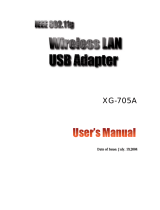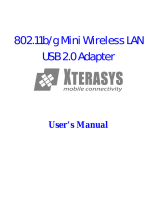Page is loading ...

CUA-854
Wireless-G Long Range
USB Adapter with Antenna
User’s Guide

2
Table of Contents
Chapter 1. Introduction....................................................................................5
1.1. About CUA-854 ......................................................................................................5
1.2. Key Features ..........................................................................................................5
1.3. Package Included...................................................................................................5
Chapter 2. Connect your antenna...................................................................6
Chapter 3. Installing Driver, Configuration Utility and Hardware.................7
3.1. Driver Installation for Windows 98SE/ME/2000/2003/XP.......................................7
3.2. Driver Installation for Windows Vista................................................................... 10
Chapter 4. Using the Configuration Utility for 98SE/ME/2000/2003/XP .....14
4.1. Overview.............................................................................................................. 14
4.2. Access the Configuration Utility........................................................................... 14
4.3. Getting to Know the Utility................................................................................... 16
4.3.1. Profile.................................................................................................................. 16
4.3.2. Link Status ......................................................................................................... 27
4.3.3. Site Survey......................................................................................................... 28
4.3.4. Statistics............................................................................................................. 30
4.3.5. Advanced............................................................................................................ 31
4.3.6. About .................................................................................................................. 33
Chapter 5. Troubleshooting ..........................................................................34

3
List of Figures
Figure 2-1 connect antenna with SMA connector.......................................................................6
Figure 3-1 AutoPlay Menu..............................................................................................................7
Figure 3-2 Setup: License Agreement..........................................................................................7
Figure 3-3 Setup: Choose Configuration TxBurst or WiFi .........................................................8
Figure 3-4 Setup: Setup Status .....................................................................................................8
Figure 3-5 Setup: plug-in message...............................................................................................9
Figure 3-6 Setup: Click Finish to Complete (for WIN2000 / 2003 / XP)......................................9
Figure 3-7 Setup: Click Finish to Complete (for WIN98 / ME) ................................................. 10
Figure 3-8 AutoPlay Confirm Window (Vista) ........................................................................... 10
Figure 3-9 AutoPlay Menu (Vista)................................................................................................11
Figure 3-10 Setup: License Agreement (Vista)..........................................................................11
Figure 3-11 Setup: Setup Status (Vista)..................................................................................... 12
Figure 3-12 Setup: plug-in message (Vista).............................................................................. 12
Figure 3-13 Setup: Found New Hardware (Vista) ..................................................................... 13
Figure 3-14 Setup: Click Finish to Complete (Vista)................................................................ 13
Figure 4-1 Utility Icon.................................................................................................................. 14
Figure 4-2 Wireless Zero Configuration: Select Manage......................................................... 14
Figure 4-3 Wireless Zero Configuration: Select Wireless Zero Configuration...................... 15
Figure 4-4 Wireless Zero Configuration: Select Disable ......................................................... 15
Figure 4-5 Utility – Profile ........................................................................................................... 16
Figure 4-6 Add Profile: Configuration ....................................................................................... 18
Figure 4-7 Add Profile: Authentication and Security: Open or Shared Key.......................... 20
Figure 4-8 Add Profile: Authentication and Security: LEAP ................................................... 22
Figure 4-9 Add Profile: Authentication and Security: WPA/ WPA-PSK/ WPA2/ WPA-PSK... 23
Figure 4-10 Add Profile: Authentication and Security: 802.1x Setting: Certification ........... 24
Figure 4-11 Add Profile: Authentication and Security: 802.1x Setting: CA Server ............... 26
Figure 4-12 Utility - Link Status.................................................................................................. 27
Figure 4-13 Utility – Site Survey................................................................................................. 28
Figure 4-14 Utility – Statistics..................................................................................................... 30
Figure 4-15 Utility – Advanced ................................................................................................... 31
Figure 4-16 Utility - Link About................................................................................................... 33

4
List of Figures
Table 4-1 Profile ........................................................................................................................... 17
Table 4-2 Configuration............................................................................................................... 19
Table 4-3 Authentication: Open or Shared................................................................................ 21
Table 4-4 Authentication: LEAP ................................................................................................. 22
Table 4-5 Authentication: WPA/ WPA-PSK/ WPA2/ WPA-PSK................................................. 23
Table 4-6 Authentication: 802.1x Setting: Ceritication............................................................. 25
Table 4-7 Authentication: 802.1x Setting: CA Server............................................................... 26
Table 4-8 Link Status................................................................................................................... 27
Table 4-9 Site Survey................................................................................................................... 29
Table 4-10 Statistics..................................................................................................................... 30
Table 4-11 Advanced.................................................................................................................... 32

5
Chapter 1. Introduction
1.1. About CUA-854
The CUA-854 is a wireless-G long range USB adapter which offers you a removable antenna with
SMA connector which can connect with any long range antenna you prefer. With a magnetic base,
it helps you easily to stick it on the metal wall and extend your network coverage significantly.
Once installed and connected, you can keep in touch with friends and work through e-mail,
instant messaging and chat rooms as well as sharing files and other network resources such as
printers and network storage with other computers.
The CUA-854 follows IEEE 802.11g wireless standard works at the speed of 54Mbps and for
added versatility; it also interoperates with all Wireless-B (IEEE 802.11b) products found at
homes, businesses, and public wireless hotspots around the country.
1.2. Key Features
The following lists the main features of the Wireless-G USB Adapter.
• 5 Times Faster and seamless operation with existing Wireless-B networks.
• 64/128-bit WEP and WPA/WPA2 (Wi-Fi Protected Access) Encryption Provides Maximum
Wireless Security.
• Compatible with Windows 98SE/ME/2000/2003/XP/Vista.
• User can change antennas according to their demand by connecting the antenna with the
SMA connector.
• The CUA-854 is with a magnet base which can be stick.
1.3. Package Included
• CUA-854 with 5 dBi or 7 dBi antenna
• CD with driver, utility and User’s Guide
• The QIG

6
Chapter 2. Connect your antenna
Figure 2-1 connect antenna with SMA connector

7
Chapter 3. Installing Driver, Configuration Utility and Hardware
3.1. Driver Installation for Windows 98SE/ME/2000/2003/XP
Before installing your long range Wireless-G USB Adapter, insert the Auto-Install CD into your
CD-ROM drive. Unless you have disabled the auto-run feature of Windows, the AutoPlay Menu
should appear automatically. If not, you can manually access the installation by clicking the Start
button and choosing Run. In the drop-down box type D:\ AUTORUN.EXE (where D: is the drive
letter for your CD-ROM drive).
Alternately, double-click My Computer and double-click on the CD drive icon.
- Click on CUA-854 to install driver/utility for your Long Range Wireless-G USB Adapter.
Figure 3-1 AutoPlay Menu
- After reading through the License Agreement, please click Yes to continue.
Figure 3-2 Setup: License Agreement
- Choose the Optimize for performance mode and click Next, you will get

8
better performance. It will enable the Tx BURST and TCP Window Size feature in the
utility.
Figure 3-3 Setup: Choose Configuration TxBurst or WiFi
Figure 3-4 Setup: Setup Status
- During the installation, there will pops up a plug-in message screen. Please insert the
Wireless-G USB Adapter into the USB port at this moment.
Figure 3-5 Setup: plug-in message

9
- In Windows XP and 2000, click Finish to complete the installation.
Figure 3-6 Setup: Click Finish to Complete (for WIN2000 / 2003 / XP)
- In Windows 98SE and ME, please select Yes, I want to restart my computer now and
click Finish to complete the installation. The system will restart automatically.

10
Figure 3-7 Setup: Click Finish to Complete (for WIN98 / ME)
Note: In Windows ME and 98SE, after the installation is completed, Windows will ask to restart
the computer, just click Yes to restart.
3.2. Driver Installation for Windows Vista
Before installing your Long Range Wireless-G USB Adapter, insert the Auto-Install CD into your
CD-ROM drive.
- There will be a Vista AutoPlay Confirm Window. Click Run AUTORUN.EXE icon.
Figure 3-8 AutoPlay Confirm Window (Vista)
- Click on CUA-854 to install driver/utility for your Wireless-G USB Adapter.
Figure 3-9 AutoPlay Menu (Vista)

11
- After reading through the License Agreement, please click Yes to continue.
Figure 3-10 Setup: License Agreement (Vista)
- The driver will be installed to your computer. The Setup Status screen will be displayed.
Figure 3-11 Setup: Setup Status (Vista)

12
- There will be a plug-in message screen. Please insert the Wireless-G USB Adapter
into the USB port now.
Figure 3-12 Setup: plug-in message (Vista)
- Click A
sk me again later when the Found New Hardware window appears.
Figure 3-13 Setup: Found New Hardware (Vista)

13
- Click Finish to complete the installation.
Figure 3-14 Setup: Click Finish to Complete (Vista)

14
Chapter 4. Using the Configuration Utility for 98SE/ME/2000/2003/XP
4.1. Overview
The wireless Configuration Utility can be used to check link information, search for available
wireless networks, or to create profiles that hold different configuration settings.
4.2. Access the Configuration Utility
The Configuration Utility icon will appear in your system tray. Double-click the icon.
Figure 4-1 Utility Icon
The utility contains six parts: Profile, Link Status, Site Survey, Statistics, Advance, and About.
You should change all your configuration settings for the Wireless-G USB Adapter by using this
utility.
Note: In Windows XP, you should disable the Wireless Zero Configuration service following the
steps below:
A. Right Click My Computer on the desktop and select Manage.
Figure 4-2 Wireless Zero Configuration: Select Manage

15
B. The Computer Management window comes up. Select Services from the Services and
Applications menu. Scroll down to locate Wireless Zero Configuration service.
Figure 4-3 Wireless Zero Configuration: Select Wireless Zero Configuration
C. Double Click on Wireless Zero Configuration to go into its properties. For Startup type,
choose Disable to disable the Wireless Zero Configuration then click Apply and OK to make
the changes effective. Now you can use our Configuration Utility instead of Windows XP
Wireless Zero Configuration Utility.
Figure 4-4 Wireless Zero Configuration: Select Disable

16
4.3. Getting to Know the Utility
4.3.1.
Profile
The Profile can keep your favorite wireless settings among your home, office and other public
hotspots. You may save multiple profiles and activate the correct one at your preference.
Figure 4-5 Utility – Profile

17
Table 4-1 Profile
LABEL DESCRIPTION
Profile Name Connection profile name. There is a connection icon standing for the
connection status,
: Indicate connection is successful on currently activated profile.
: Indicate connection fails on currently activated profile.
SSID Wireless station or ad-hoc name.
Channel Channel in use for this wireless connection.
Authentication The Authentication method used for this profile.
Encryption The Encryption type used for this profile.
Network Type The Network type used for this profile.
Add Click Add to create a new profile.
Delete Click Delete to delete a selected profile.
Edit Select a profile, and click Edit to change an existing profile.
Activate To activate a specific profile, select the profile, and click Activate button.
OK To pop-down this utility menu.
Help Click Help to display on-line help information in a pop-up screen.

18
4.3.1.1. Create a New Profile
Click the Add button on the Profile screen to create a new profile.
(A) Add Profile: Configuration
Fill the Profile Name and SSID for this new profile.
Figure 4-6 Add Profile: Configuration

19
Table 4-2 Configuration
LABEL DESCRIPTION
Profile Name Enter the profile name that you want.
SSID User can key in the intended SSID name or use pull down menu to
select from available wireless network.
PSM CAM (Constantly Awake Mode) – the wireless Adapter will stay full
power when AC power cord is plugged into power outlet.
PSM (Power Saving Mode) – the wireless Adapter will enter the power
saving mode.
Network Type There are two wireless modes.
(A) Infrastructure - This mode allows wireless and wired networks to
communicate through an access point.
(B) Ad-hoc - This mode allows wireless-equipped computers to
communicate directly with each other.
Preamble There are three types: Auto, Long and Short are supported.
Ad-hoc wireless
mode
There are three types: 802.11B only, 802.11B/G mixed and 802.11G only
modes are supported.
TX Power Transmit power, the amount of power used by a radio transceiver to
send the signal out. User can choose power value by sliding the bar.
RTS Threshold User can adjust the RTS threshold number by sliding the bar or key in
the value directly. The default value is 2347.
Fragment Threshold User can adjust the Fragment Threshold number by sliding the bar or
key in the value directly. The default value is 2346.
Channel Only available for setting under ad-hoc mode. User can choose the
channel frequency to start their ad-hoc network.
OK Confirms and saves the settings.
Cancel Ignore the settings and return to the previous screen.
Help Click Help to display on-line help information in a pop-up screen.

20
(B) Add Profile: Authentication and Security
Enter the authentication and security information here.
Figure 4-7 Add Profile: Authentication and Security: Open or Shared Key
/

